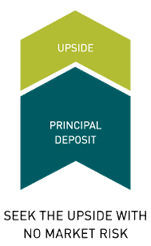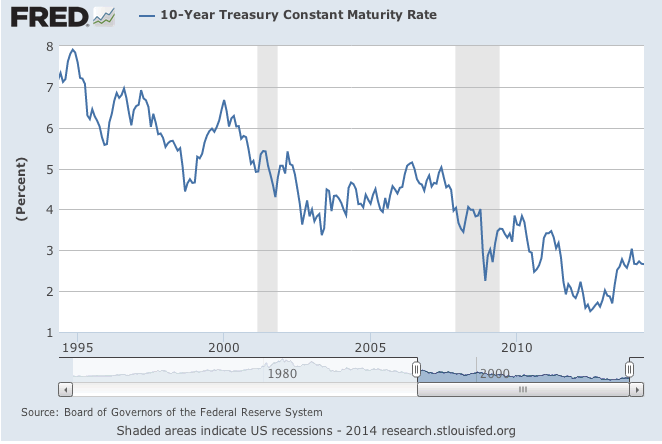 Interest rates remain very low, but at the same time we are constantly being warned that they could spike up soon. What is a conservative investor to do?
Interest rates remain very low, but at the same time we are constantly being warned that they could spike up soon. What is a conservative investor to do?
Everbank’s lineup of MarketSafe CDs are a new wrinkle on FDIC-insured bank CDs that try to take advantage of these current low interest rates. They are basically a hedged bet on something like currencies, precious metals, or commodities. If things don’t work out, the principal you put in is protected with FDIC insurance so you’ll always get that back, just with no interest in the worst case. If your selected market bet does pan out, you’ll get an interest payment based on that upside.
Their newest product is the 5-yr MarketSafe Treasury CD which bets on rising interest rates. I don’t pay much attention to gold or currency prices, but interest rates are easier to understand. Here’s the pitch:
With this latest MarketSafe CD, seek 3.3 times any upside growth in the 10-year Treasury yield during the CD term.3 Full protection of your deposited principal comes standard.1 Act by June 11, 2014 to take advantage.
Sound intriguing, but as usual let’s dig into the details.
The CD has a term of 5 years. You must fund it by 6/11/2014 and the maturity date is 6/21/2019 where you’ll get your principal plus any interest accrued (“market upside payment”). You can’t make any early withdrawals (well, technically you can but you lose the principal protection and are subject to penalties). The minimum opening deposit is $1,500. No monthly or account fees. Available for IRAs.
The market upside payment is based on the following formula using the 10-Year US Treasury yield:
(yield at maturity - initial yield) x 3.3 x deposited principal
Comments:
- While the formula multiplies the rate difference by 3.3, this includes all the interest you’ll get for 5 years. As an example, if you had a 5-year CD paying 2% annually, that’s a 10.4% total return at the end of 5 years. (You can find a 5-year CD at 2.25% APY at GE Capital Retail Bank).
- The current 10-year Treasury yield is roughly 2.6% (this could change by issue date). If you want a 10% return after 5 years from this MarketSafe CD, 10-year yields would have to rise by 3% to 5.6% in June 2019.
- If the 10-year Treasury yield stays constant or drops between the initial date and maturity date, you will only get back your original principal.
I won’t make a rate prediction because I have no idea where rates are headed. Here’s a historical chart of the 10-year Treasury yield over the last 20 years (FRED):

The last time the 10-year yield was near 5.5% was around 2002. Rates would have to go higher than that to beat a top 5-year traditional CD. However, keep in mind that with this product you are getting both upside potential and principal protection. In exchange for such risk reduction, it can’t be a slam dunk. If rates do rise up to say 5.5%, then the people who actually bought 10-year bonds today would be looking at a significant loss of principal.
 The Best Credit Card Bonus Offers – 2025
The Best Credit Card Bonus Offers – 2025 Big List of Free Stocks from Brokerage Apps
Big List of Free Stocks from Brokerage Apps Best Interest Rates on Cash - 2025
Best Interest Rates on Cash - 2025 Free Credit Scores x 3 + Free Credit Monitoring
Free Credit Scores x 3 + Free Credit Monitoring Best No Fee 0% APR Balance Transfer Offers
Best No Fee 0% APR Balance Transfer Offers Little-Known Cellular Data Plans That Can Save Big Money
Little-Known Cellular Data Plans That Can Save Big Money How To Haggle Your Cable or Direct TV Bill
How To Haggle Your Cable or Direct TV Bill Big List of Free Consumer Data Reports (Credit, Rent, Work)
Big List of Free Consumer Data Reports (Credit, Rent, Work)
This is interesting from the perspective of being an innovative financial product, but it seems way to gimmicky to be worth considering. Nice job, Jonathan, presenting the math and showing that this very likely isn’t a very generous deal. Taking a look at the “term sheet” on the website but, admittedly, not the CD Terms & Conditions, it looks like there are potentially some unusual income tax consequences with “deemed interest” reported to you:
“OID: See MarketSafe Certificate of Deposit Terms & Conditions for information related to tax implications, if you do not hold this Product in a qualified tax-deferred account. The Deemed Interest Rate will be based on the comparable EverBank Yield Pledge CD rate for an equivalent term. Final rate for purposes of OID will be determined on the Close Date of the Offering Period and reflected on the confirmation.”
I’m not a tax pro, but OID interest should be taxed as ordinary income just as “normal bank account” interest income would be.
Some of the strongest advice I can give to anyone is NEVER buy financial products with embedded options. The average person (and average professional I might add) is not capable of properly pricing financial derivatives like this CD’s embedded rate option. Financial institutions know this and only create these complicated instruments to obfuscate their value.
While it is all but impossible to price this thing on your own very liquid financial markets exist that trade both the interest rate risk and volatility needed to value it. Treasury options don’t go out 5 years but swaps work just as well. A derivative contract that pays the excess of the 10 year swap rate taken 5 years from today over the current 10 year swap rate would cost you 1.55% of notional. Multiply by the 3.3 leverage factor and Everbank is paying 5.12% to borrow money for 5 years with the interest rate risk of the option completely hedged. Compare this to the ~10% cost that you quote as a going rate for a similar standard CD.
Totally agree. And it isn’t necessary for the average investor to be able to price the options built into these products because it is a certainty that they will be overpaying for them.